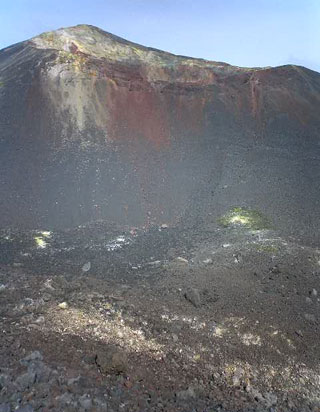Marie Claire - Nicaragua’s New Wave
July 2007
For years, the only news from Nicaragua was or revolution and earthquakes. Now, it’s a hip new travel destination, where, says Michelle Jana Chan, all you need pack is hiking boots and a bikini.

Flying into Nicaragua with my friend Kate, I realise that the largest country in Central America has been in the back of my mind for years. I can remember the grainy black-and-white shots of Nicaraguan model Bianca marrying Mick Jagger in St Tropez back in 1971, the dirty dealings of Oliver North and the Contras, and I still love The Clash’s epic triple album, Sandanista!.
For decades, this impassioned nation seemed lost to guerilla war and poverty, while its neighbour, Costa Rica, raked in the tourist dollars with its similar mix of spectacular volcanoes and exuberant rainforest. When the fighting finally ended in 1990, democratic elections and a gradual economic recovery followed. Last November, the left-wing Sandanistas were returned to power, but their leader, Daniel Ortega, has mellowed since those heady, revolutionary days. Now, Nicaragua welcomes foreign investment -- and tourists. For the moment, that mostly means independent travellers looking for somewhere safe, stimulating and a little ahead of the crowd.
With abandoned tanks by the roadside and impassioned political graffiti, the Nicaraguan capital, Managua, still feels like the rundown city that inspired the U2 track Where The Streets Have No Name. As life improves, shopping malls have become the social hub where young people meet and flirt, and the city’s worth a stop just to see its crumbling cathedral, tarnished statues of martyrs and eerie monument to the unknown guerilla soldier.
The future of Nicaragua, though, lies elsewhere in places such as Granada, its loveable old colonial capital, just a two-hour drive south. Kate and I hire a car and driver, breaking the journey at Masaya, where there’s a vibrant craft market. We suck on juicy mangoes, then wander through the stalls, admiring embroidered cotton tops and beaded leather belts. The prices are irresistible: a colourful hand-woven hammock costs a fiver, jute handbags made from coffee sacks are £3, and just £4 gets you a T-shirt emblazoned with the figure of Augusto Sandino, Nicaragua's Che Guevara.
Granada overlooks Lake Nicaragua, which could be an ocean with its rough waves and freshwater sharks. We stay at homely hotel La Casona de los Estrada, where hummingbirds buzz about the garden and parakeets chatter in the trees. I wander off to visit the Convento de San Francisco, with ancient basalt statues like those on Easter Island, then sit in a park fending off shoeshine boys begging to polish my flip-flops.
One reason travellers are now coming to Nicaragua is for is glorious Pacific beaches. We pick up the Pan-American Highway and head south to San Juan del Sur, a surfer town full of cute boys talking about waves and boho travellers learning Spanish. The port has a sweeping bay with a cruise ship terminal at one end and abandoned fishing boats at the other -- a sign of how things are changing. There’s also a string of rustic bars offering shellfish; we choose El Timón and dine on lobster for a fiver.
Half and hour’s drive north lies Nicaragua's swankiest hotel, Morgan's Rock Hacienda and Ecolodge, which has beautiful bungalows built with sustainable tropical woods. Kate and I tour its nature reserve, go bodysurfing at the sweeping private beach, then relax with a massage. We sip cocktails at the poolside bar with American honeymooners, and learn if you visit between August and January the staff will wake you up to watch turtles come ashore and lay their eggs.
North of here, the coastline is more rugged and remote, with some beaches only accessible by boat. This is where the serious surfers go -- as well as locals trying to sell a seafront plot to foreigners with a head full of dreams. Sadly, the prices are already too steep to consider an investment, but I yearn to stay here for another lazy week.
Instead, though, we head inland to Nicaragua’s volcano country. A long chain of fiery peaks runs north from Lake Managua, and with names like Momotombo and Mombacho, it sounds like they’re already grumbling. We drive into a landscape of hulking mountains billowing smoke, with great swathes of solidified lava flows and tranquil crater lakes.
The day we arrive, San Cristóbal, the country's highest volcano, is playing up that day so everyone’s a bit jumpy. But our driver Juan-Pablo, agrees to accompany me on a trek and we decide to climb Cerro Negro, Nicaragua’s youngest volcano and one of the most active. Nothing grows on its steep slopes and it’s a 90-minute ascent without any shade. When we reach the crater edge, we walk through swirling smoke and over valves spurting sulphurous vapour, touching rocks streaked green and yellow with minerals.
When it's too dangerous for such a trek, the next best view of this awesome terrain is from the roof of the cathedral in León. With a lively student community, this former capital city has the best nightlife in Nicaragua. Here we challenged some locals to a game of pool and drunk too much Flor de Caña rum.
New roads are now starting to criss-cross the country, and the crime rate is said to be the lowest in Central America. Everyone’s talking of new surf camps and boutique hotels popping up on the coast, and it’s abundantly clear that Nicaragua is ready and open for business. Of course, if you look outside, there’s not a tourist in sight -- yet. And that’s just how I like it.




